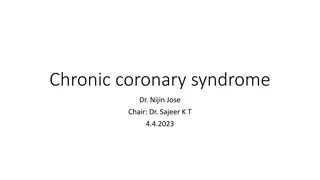Understanding Marfan Syndrome: Causes, Symptoms, and Effects
Marfan Syndrome is a genetic disorder affecting connective tissue, leading to various physical manifestations such as long limbs, heart and eye issues, and more. This article explores the history, inheritance pattern, symptoms, effects, and diagnosis of Marfan Syndrome, shedding light on the challenges faced by individuals with this condition.
Download Presentation

Please find below an Image/Link to download the presentation.
The content on the website is provided AS IS for your information and personal use only. It may not be sold, licensed, or shared on other websites without obtaining consent from the author. Download presentation by click this link. If you encounter any issues during the download, it is possible that the publisher has removed the file from their server.
E N D
Presentation Transcript
MARFANS SYNDROME By: Anthony G., Breanna C., and Stefania P.
MARFANS SYNDROME WHO? Marfan s Syndrome is named after Antoine Marfan, the French doctor who discovered it in 1896. In 1896 Marfan, presented the case of a 5-year-old girl, Gabrielle. Marfan pointed out Gabrielle's extremely long limbs. Her mother had noticed this already at birth. The fingers and toes were exceptionally long and slender, making a spider-like impression. So then Marfan s Syndrome was founded.
WHAT IS MARFANS SYNDROME, AND HOW IS IT INHERITED? Marfans Syndrome is a disorder that affects the connective tissue, so its not as strong as it would be. This results in long limbs. This is passed down by a non sex- linked (autosomal) dominant pattern, which means one copy of the altered gene in each cell is plentiful to cause the disorder. At least 25 percent of Marfan syndrome cases result from a new alteration in a gene.
This is a pedigree chart that shows how Marfan Syndrome got passed down.
MARFAN SYNDROME SYMPTOMS Marfan syndrome affects people in different ways. Some people have only mild symptoms, and others have severe problems. Most of the time, the symptoms get worse as the person gets older. People with Marfan syndrome are often very tall, thin, and loose jointed. They may have: Bones (arms, legs, fingers, and toes) that are longer than normal, crowded teeth because the roof of the mouth is arched, a breastbone that sticks out or caves in, a curved backbone Most people with Marfan syndrome have problems with the heart and blood vessels, such as: a weak part of the aorta (the large artery that carries blood from the heart to the rest of the body). Some people with Marfan syndrome have problems with the eyes, such as: Nearsightedness, Glaucoma (high pressure within the eye) at a young age, Cataracts (the eye s lens becomes cloudy) Many people with Marfan syndrome have: Stretch marks on the skin. These are not a health problem. A hernia (part of an internal organ that pushes through an opening in the organ s wall).
EFFECTS OF MARFANS SYNDROME A genetic disorder can cause social, emotional, and financial stress. It often requires changes in outlook and lifestyle. People with Marfan syndrome may feel many strong emotions, including anger and fear. They may also be concerned about whether their children will have Marfan syndrome. It helps people with Marfan syndrome to have a proper medical care and a strong social support.
HOW DO DOCTORS DIAGNOSE MARFANS SYNDROME? A doctor determines whether or not you have Marfan s Syndrome based on your medical/family histories, and physical exam. Medical and Family Histories: Your doctor will ask about your medical history and your family's medical history. For example, your doctor may ask whether: You've had heart disease, eye problems, or problems with your spine. These complications are common in people who have Marfan syndrome. You have shortness of breath, palpitations, or chest pain. These are common symptoms of heart or lung problems linked to Marfan syndrome. Any of your family members have Marfan syndrome, have died from heart problems, or have died suddenly. Physical Exam: During the physical exam, your doctor will look for Marfan syndrome traits. For example, he or she may check the curve of your spine and the shape of your feet. Your doctor also will listen to your heart and lungs with a stethoscope.
PROGNOSIS OF MARFAN SYNDROME If unrecognized or left untreated, the average life expectancy for a patient with Marfan syndrome is 45 years. However, if properly managed, patients with Marfan syndrome can have a normal life expectancy. If you have Marfan syndrome, you'll need regular checkups with the doctor: Regular visits with a heart specialist to check for problems with your heart valves and aorta. (The aorta is the main blood vessel that supplies oxygen-rich blood to the body.) Annual checkups with a bone specialist to look for changes in your spine and breastbone. Regular eye exams with a eye specialist to find and treat eye problems early.
TREATMENT While Marfan syndrome is a condition that cannot be cured, you can live a long, full life with proper treatment and management. In general, you can expect some things you need to think about every day, such as medications and limitations on physical activity. Then, there are routine doctor appointments, which may be yearly or more frequent, as well as other evaluations to make sure that your symptoms are not worsening. Sometimes, when symptoms progress, your doctor will recommend surgery. In some cases, you will have time to plan for an operation; in other cases, immediate surgery may be needed.
CURRENT RESEARCH Currently the Marfan Foundation is doing all they can to find out a way to help people with Marfan Syndrome. As a result of a long-time commitment to advancing this research, the Marfan Foundation have turned the tide for Marfan research. They work with world-class scientists who are equally dedicated to. In addition, the research that they have done has identified new disorders related to Marfan syndrome, which not only allows for better, more specific diagnoses, but also helps to pinpoint more effective treatments for Marfan syndrome and the related disorders.
Mutations in the FBN1 or fibrillin gene on chromosome 15 cause a genetic disorder called Marfan syndrome. The misshapen protein from the mutated gene weakens the connective tissues in the body.
MARFAN SYNDROME SUMMARY About a month before Isaiah Austin was expected to become a first round pick in the NBA draft,he found himself in the office of a heart specialist, getting a second opinion about a problem that came up during a routine physical by league doctors. Dr. Robert Bonow sees a handful of these referrals every year, almost always false alarms. Bonow wasn t so sure this time. Austin indeed had many characteristics of Marfan syndrome, a condition that is potentially fatal and certainly career-ending. The definitive answer would come from a blood test. Results wouldn t arrive until shortly before the draft. Despite all of that hanging in the balance, Austin he never even Googled the words Marfan syndrome. Years before, an injury stole the vision in his right eye. Austin powered on, fueled by his faith, becoming an All-American in high school and a star at Baylor University. So whatever the future held, he d be ready for it.
WORK CITED Brown, Nancy. "His NBA Dream Lost, Isaiah Austin Winning in New Ways." The Huffington Post. TheHuffingtonPost.com, n.d. Web. 06 Apr. 2016. "How Is the Body Affected?" How Is the Body Affected? N.p., n.d. Web. 06 Apr. 2016. "Marfan Syndrome." Fast Facts About. N.p., n.d. Web. 06 Apr. 2016. "Marfan Syndrome." Fast Facts About. N.p., n.d. Web. 06 Apr. 2016. "Marfan Syndrome: Get Facts on This Genetic Tissue Disorder." MedicineNet. N.p., n.d. Web. 07 Apr. 2016. "Marfan Syndrome: Get Facts on This Genetic Tissue Disorder." MedicineNet. N.p., n.d. Web. 31 Mar. 2016. "What Is Marfan Syndrome?" - NHLBI, NIH. N.p., n.d. Web. 06 Apr. 2016.























